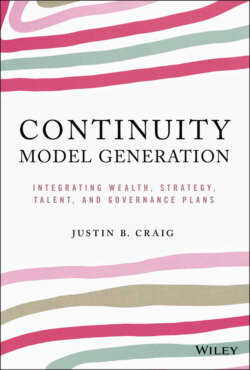Читать книгу Continuity Model Generation - Justin B. Craig - Страница 22
Four Ps Framework
ОглавлениеRelated to the RIPCC framework, the four Ps framework is again unabashedly stolen and paraphrased from Ward's work. And again, I can't direct you to exactly which publication it came from, but somewhere in those volumes is a section that relates to these four dimensions. From his experience observing and working with all types of business-owning families, Ward suggests there are four critical priorities, all of which start with “p.” The first priority is parenting, and this is hard to argue against when you consider we are talking about families. The major contributors to the next generation, and this is really relevant for continuity modelling, are the parents, as reflected in the example I included in the earlier discussion of the big tent framework. Ward's recommendation here is that, to increase chances of harmony, optimal functioning, meaningful contributions, and other desirables, there needs to be a focus on being exemplary parents. The second “p” relates to familial process. My interpretation is that, too often, families get out of whack and forget to introduce ways to appreciate the fact that they are family. Most anyone involved in family business will agree that they are guilty of spending inordinate time talking about or being involved in the business, at the expense of their family. So, the second priority needs to be consciously and intentionally addressed by finding ways to include reminders that the family is a family. The third priority is one that receives immediate positive response whenever I share it: the imperative to put in place protocols before you need them. This refers especially to governance protocols and processes that set the expectations for now- and next-generation involvement, for example. The fourth priority is to develop a sense of purpose and understand the general and specific responsibilities of being part of a business-owning family (Illustration 10).
So, again, a lot of work and thinking has gone into understanding the priorities that a family should have. Parenting, familial processes, having protocols in place before they are needed, and developing a shared sense of purpose will individually and collectively contribute to addressing assumptions and be foundational in developing a continuity model mindset within the family.
Illustration 10 THE FOUR Ps FRAMEWORK
